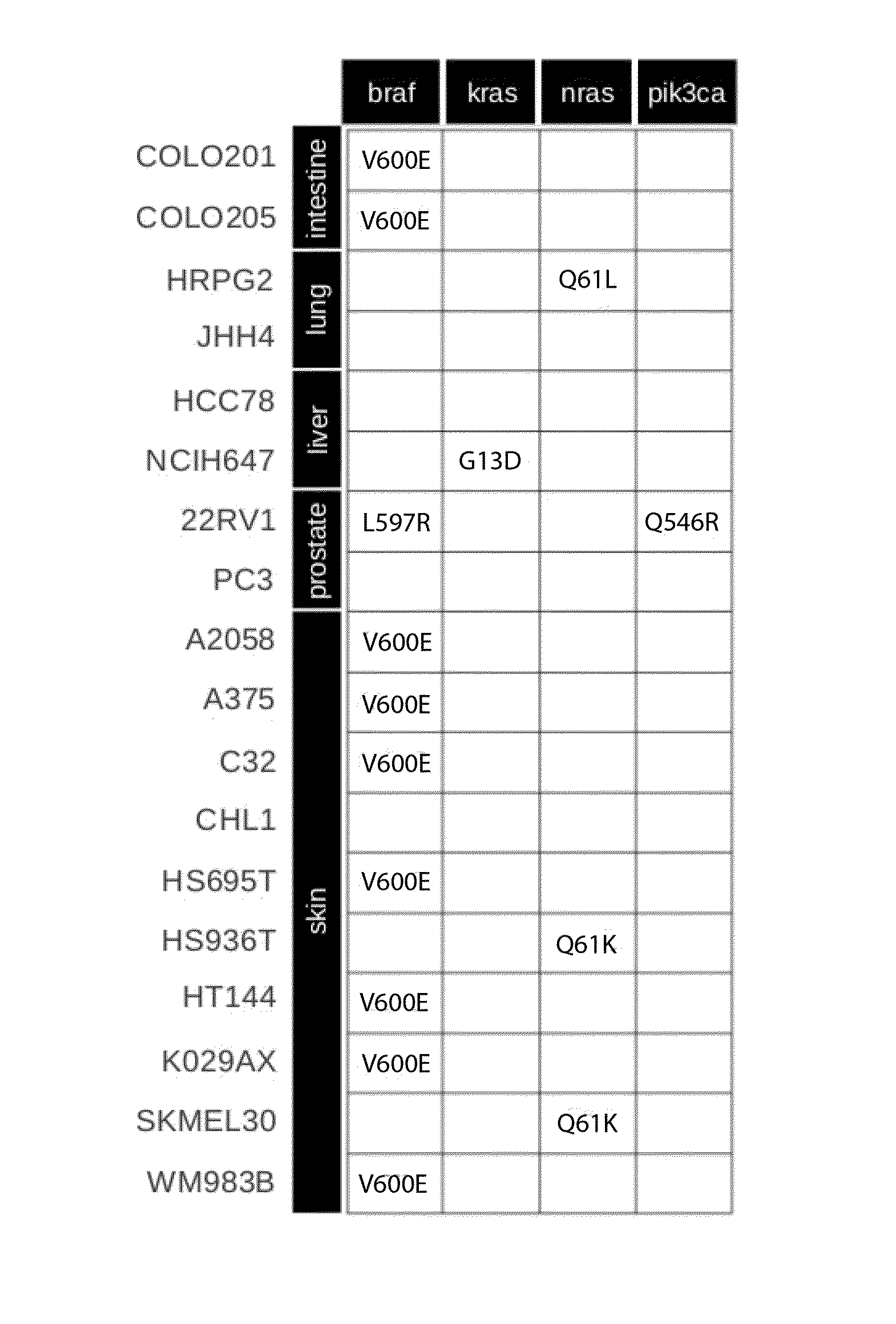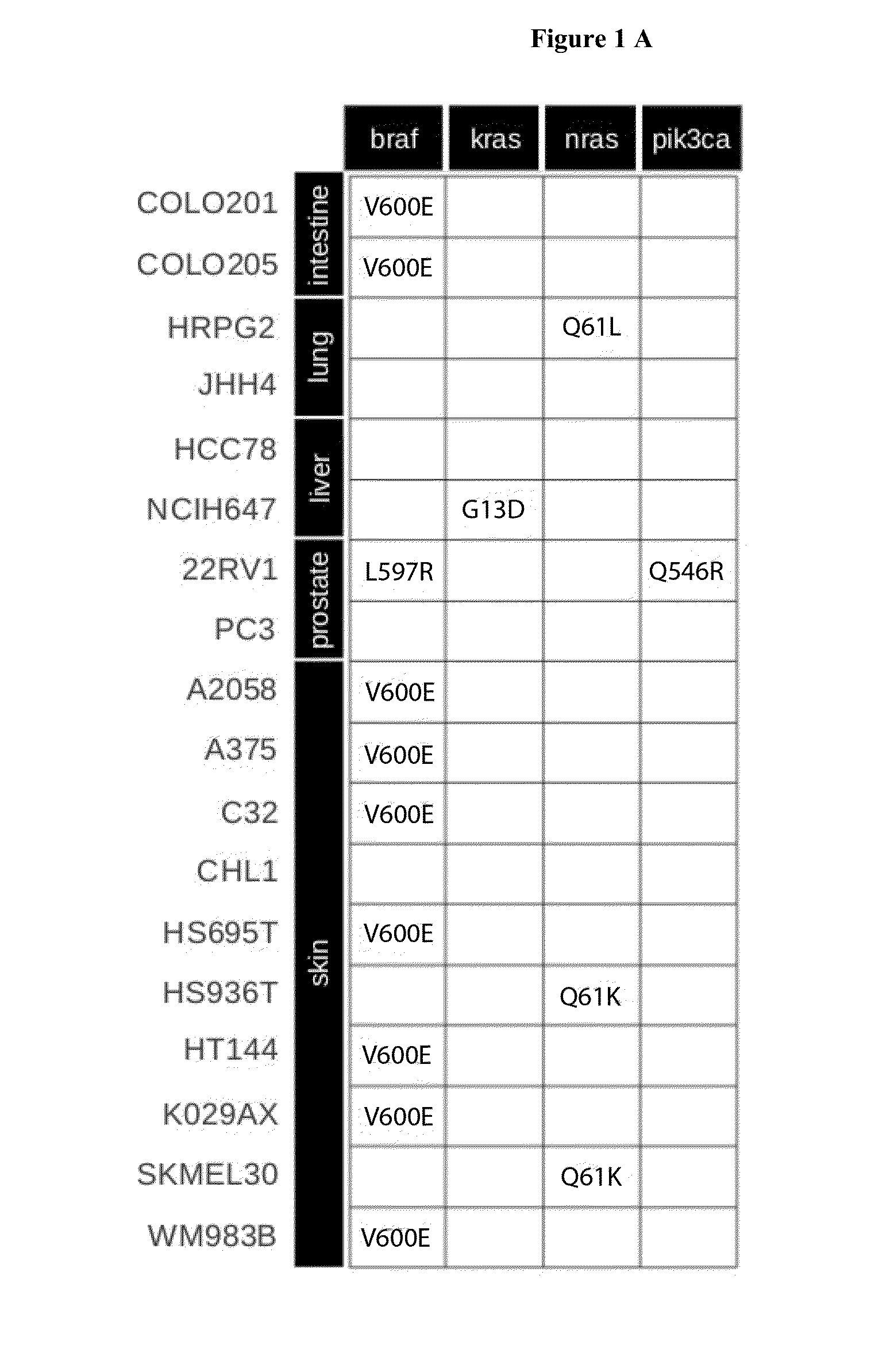Computational Approach for Identifying a Combination of Two Drugs
a combination and drug technology, applied in computing, drug and medication, instruments, etc., can solve the problems of unavoidable limitations of the strategy, the inability to take into account complex data on the regulation and connectivity of cancer pathways, and the inability to accurately predict the effect of drug combination
- Summary
- Abstract
- Description
- Claims
- Application Information
AI Technical Summary
Benefits of technology
Problems solved by technology
Method used
Image
Examples
example 1
[0071]Individual in silico models of 18 selected cancer cell lines were generated. The cell lines were selected to include a range of different tissue type origin (skin, lung, prostate, liver, intestine), different pathway activity states and spectrum of mutations covered currently by the model (FIG. 1). A generic mathematical cancer model was generated for each cell line with cell line specific data on gene expression and somatic mutations for each cell line. Mutations were introduced into the model by gain-of-function effects for oncogenes according to information in databases. In total, within the selected cancer cell lines we identified 6 different mutations in 4 different oncogenes that were covered by our generic cancer model and consequently have been taken into account as activating mutations (FIG. 1A). Normalized relative gene expression values were used for the initialization of the synthesis rates of the corresponding proteins within the model reflecting the differences i...
example 2
[0073]The individual cancer cell line models were employed to model the drug action of 12 molecular targeted drugs for which pharmacological profiles were available from CCLE (Barretina et al. Nature 483, 603-607 (2012)). To generate predicted growth inhibition curves, we simulated a concentration range of 8 μM to 2.5 nM (8 point dose response) by 3.16-fold dilutions for every compound. Inhibitor components in the model as well as kD values of corresponding inhibition reactions were initialized according to desired concentration and to information in drug databases that contains the main targets (and if available the off-targets) of every drug as well as the binding affinities (kip values) of a drug to its targets.
[0074]After simulation for each parameter setting, the final steady state concentration ratio (cell line state vs. control state and treated cell line state vs. control state, respectively; c-Myc was computed as a surrogate marker for cell proliferation. This yielded a ser...
example 3
[0079]It was further investigated how the model compares to predictions of treatment based on current single marker predictions (e.g. BRAF V600E). Vemurafenib (an analogue of the pre-clinically tested PLX4720) is approved as monotherapy for the treatment of BRAF V600E mutation positive metastatic melanomas. However, resistance to Vemurafenib frequently occurs due to receptor tyrosine kinase-mediated activation of alternative survival pathways, activated RAS-mediated reactivation of the MAPK pathway and increased signaling through RAF1. Although 7 of the 10 melanoma cell lines analyzed harbour a BRAF V660E mutation (A2058, A375, C32, HS695T, HT144, K029AX, WM983B), only 3 of them show sensitivity to Vemurafenib treatment as revealed by CCLE measurements. The kinetic model in contrast identified 4 of the 7 BRAF V600E-mutated melanoma cell lines correctly as resistant to Vemurafenib. This confirms that the use of a single biomarker is not sufficient to reliably predict treatment outcom...
PUM
 Login to View More
Login to View More Abstract
Description
Claims
Application Information
 Login to View More
Login to View More - R&D
- Intellectual Property
- Life Sciences
- Materials
- Tech Scout
- Unparalleled Data Quality
- Higher Quality Content
- 60% Fewer Hallucinations
Browse by: Latest US Patents, China's latest patents, Technical Efficacy Thesaurus, Application Domain, Technology Topic, Popular Technical Reports.
© 2025 PatSnap. All rights reserved.Legal|Privacy policy|Modern Slavery Act Transparency Statement|Sitemap|About US| Contact US: help@patsnap.com



